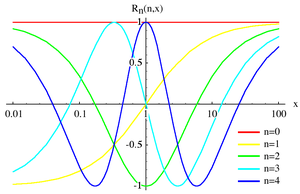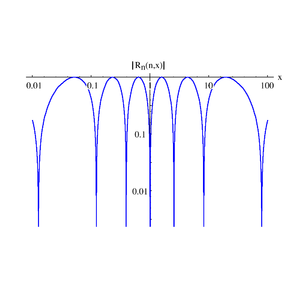Chebyshev rational functions
- Chebyshev rational functions
-
- This article is not about the Chebyshev rational functions used in the design of elliptic filters. For those functions, see Elliptic rational functions.

Plot of the Chebyshev rational functions for n=0,1,2,3 and 4 for
x between 0.01 and 100.
In mathematics, the Chebyshev rational functions are a sequence of functions which are both rational and orthogonal. They are named after Pafnuty Chebyshev. A rational Chebyshev function of degree n is defined as:

where Tn(x) is a Chebyshev polynomial of the first kind.
Properties
Many properties can be derived from the properties of the Chebyshev polynomials of the first kind. Other properties are unique to the functions themselves.
Recursion

Differential equations


Orthogonality

Plot of the absolute value of the seventh order (
n=7) Chebyshev rational function for
x between 0.01 and 100. Note that there are
n zeroes arranged symmetrically about
x=1 and if
x0 is a zero, then
1/x0 is a zero as well. The maximum value between the zeros is unity. These properties hold for all orders.
Defining:

The orthogonality of the Chebyshev rational functions may be written:

where cn equals 2 for n=0 and cn equals 1 for  and δnm is the Kronecker delta function.
and δnm is the Kronecker delta function.
Expansion of an arbitrary function
For an arbitrary function  the orthogonality relationship can be used to expand f(x):
the orthogonality relationship can be used to expand f(x):

where

Particular values






Partial fraction expansion

References
Wikimedia Foundation.
2010.
Look at other dictionaries:
Elliptic rational functions — In mathematics the elliptic rational functions are a sequence of rational functions with real coefficients. Elliptic rational functions are extensively used in the design of elliptic electronic filters. (These functions are sometimes called… … Wikipedia
Chebyshev polynomials — Not to be confused with discrete Chebyshev polynomials. In mathematics the Chebyshev polynomials, named after Pafnuty Chebyshev,[1] are a sequence of orthogonal polynomials which are related to de Moivre s formula and which can be defined… … Wikipedia
Pafnuty Chebyshev — Chebyshev redirects here. For other uses, see Chebyshev (disambiguation). Pafnuty Chebyshev Pafnuty Lvovich Chebyshev Born May 16, 1821 … Wikipedia
List of mathematical functions — In mathematics, several functions or groups of functions are important enough to deserve their own names. This is a listing of pointers to those articles which explain these functions in more detail. There is a large theory of special functions… … Wikipedia
Trigonometric functions — Cosine redirects here. For the similarity measure, see Cosine similarity. Trigonometry History Usage Functions Generalized Inverse functions … Wikipedia
Continued fraction — Finite continued fraction, where a0 is an integer, any other ai are positive integers, and n is a non negative integer. In mathematics, a continued fraction is an expression obtained through an iterative process of representing a number as the… … Wikipedia
List of mathematics articles (C) — NOTOC C C closed subgroup C minimal theory C normal subgroup C number C semiring C space C symmetry C* algebra C0 semigroup CA group Cabal (set theory) Cabibbo Kobayashi Maskawa matrix Cabinet projection Cable knot Cabri Geometry Cabtaxi number… … Wikipedia
Elliptic filter — An elliptic filter (also known as a Cauer filter, named after Wilhelm Cauer) is an electronic filter with equalized ripple (equiripple) behavior in both the passband and the stopband. The amount of ripple in each band is independently adjustable … Wikipedia
List of trigonometric identities — Cosines and sines around the unit circle … Wikipedia
Cubic function — This article is about cubic equations in one variable. For cubic equations in two variables, see elliptic curve. Graph of a cubic function with 3 real roots (where the curve crosses the horizontal axis where y = 0). It has 2 critical points. Here … Wikipedia
 Plot of the absolute value of the seventh order (n=7) Chebyshev rational function for x between 0.01 and 100. Note that there are n zeroes arranged symmetrically about x=1 and if x0 is a zero, then 1/x0 is a zero as well. The maximum value between the zeros is unity. These properties hold for all orders.
Plot of the absolute value of the seventh order (n=7) Chebyshev rational function for x between 0.01 and 100. Note that there are n zeroes arranged symmetrically about x=1 and if x0 is a zero, then 1/x0 is a zero as well. The maximum value between the zeros is unity. These properties hold for all orders.
 and δnm is the Kronecker delta function.
and δnm is the Kronecker delta function. the orthogonality relationship can be used to expand f(x):
the orthogonality relationship can be used to expand f(x):















